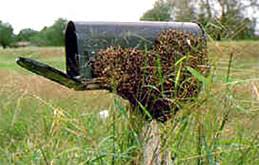Ever seen a bunch of honey bees on your porch, mailbox, car, or in a tree? That's a honey bee swarm, and late April through May is swarm season in our area. (By the way, other insects swarm as well, so if they are in the ground that's yellow jackets not honey bees). Swarming is a natural behavior of honey bees. Depending on the weather, in our area, the queen starts laying eggs in early March to start building up the number of bees in the hive. The goal is to have as many bees in the hive as possible by nectar flow when all the flowers are really popping in late June through July. To make that happen, she needs empty space in the hive to lay eggs in the cells of the beeswax. The bees then work all summer to fill the hive with honey for the winter, when she doesn't lay as many eggs. Right now, there is relatively little honey in the hive because they ate it this winter and there are a lot of empty beeswax cells for her to use to produce offspring.
But each hive only has one queen and about 80,000 bees at it's fullest. So, this time of year, as the bees feel crowded in the hive with all those eggs and new bees emerging that she laid in mid-March, they build queen cells in which the queen lays an egg that eventually will become a queen. Just before the new queen emerges, the old queen take about 2/3rds of the bees from the hive in a swarm. The new queen mates one time in her life with many male bees called drones within a few days, and then she comes back and begins laying eggs in the old hive that are cared for by the bees that stayed behind.
The old queen and the swarm of bees form a large ball about the size of a basketball that typically goes to the tallest tree near the hive. However, they may go several miles from the old hive to find a new home. Sometimes that home is under a porch, in a the walls of a house, etc. Typically, it's in a hollow tree where they are better protected.
Last year, it was really rainy and cold the last weeks of April and early May, and I happened to get the chance to get in the bee yard to split our hives on two days when the bees actually swarmed from hives when I was present. Imagine being surrounded by thousands of bees that made a cloud head high about 30 feet wide! I'll admit, that was too much for me. I walked away rather quickly to give them plenty of space and watched from a safe distance. That swarm stayed in a cloud and I watched them go down the lane on the farm and go into the nearby woods about 3/4 of a mile away. It took about 10 minutes before they were all gone. In the other occurrence, I arrived in another bee yard that is on the edge of a large woods and the bees had just swarmed. As I exited the truck I could see them filling the canopy of the trees about 40 feet wide as they ultimately landed on a large branch. In both cases, the sound of the buzzing was overwhelming. I never found the swarm that flew away, although I drove along the woods to see if I could find it, and the swarm I did see on the branch stayed that day and was gone the next.
Please, please, please do not spray a swarm of honey bees to kill them! Many beekeepers will be happy to collect the swarm and put it in one of their hives for FREE. Generally, the bees are relatively docile in a swarm and a beekeeper can simply knock them of a tree limb into a container (like a trash can with a lid) and then shake them into a hive. As long as the queen goes in and stays, the rest of the bees will stay with her in the swarm. The beekeeper will typically put a frame or two of honey in the hive, and they are happy to stay in the hive because of the honey.
There is a list of beekeepers who would like to take swarms off your hand in the area. Just go to the Northeastern Indiana Beekeepers Association website at https://www.neiba.info/ and call the number for swarm removal. (I do not do swarm removal unless they are easily accessed. I'm not a fan of climbing ladders or crawling under houses. However, beekeepers on the swarm list have the equipment to access them in more difficult spaces).
Have you had a swarm on your property? Tell us about it by replying to this post!
Bee Great and please don't kill a swarm!

